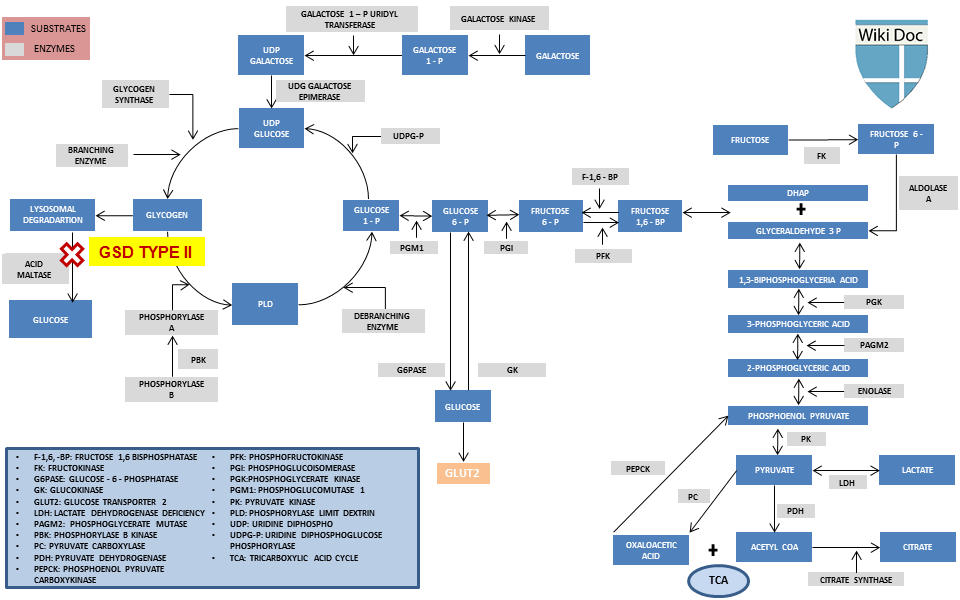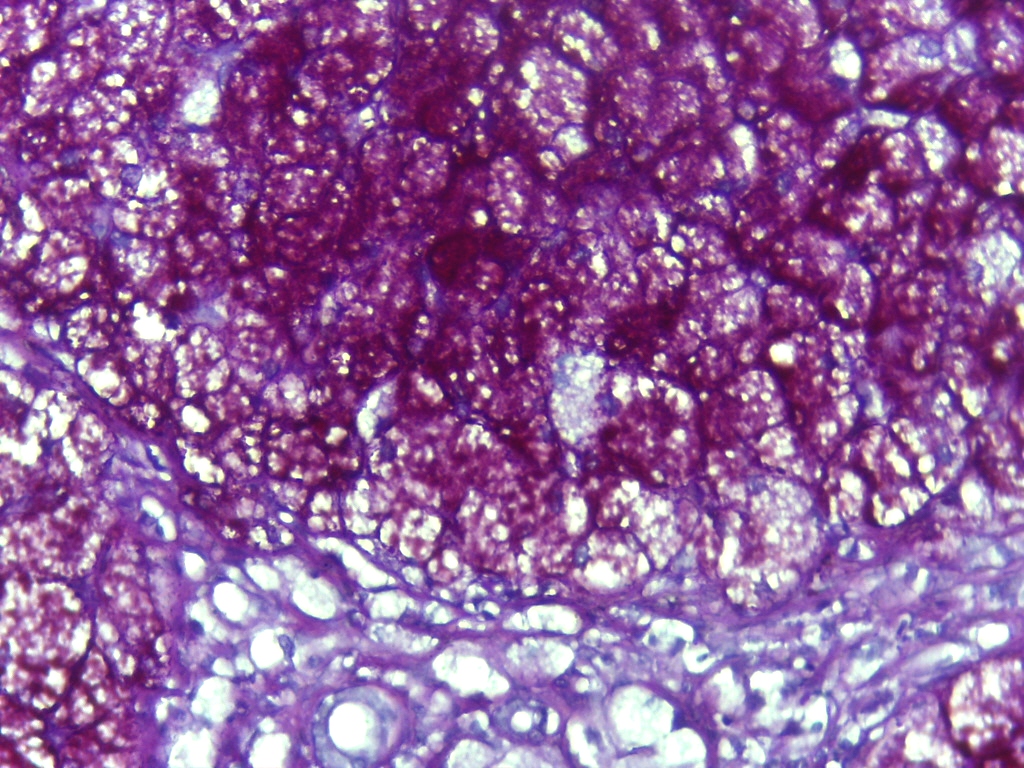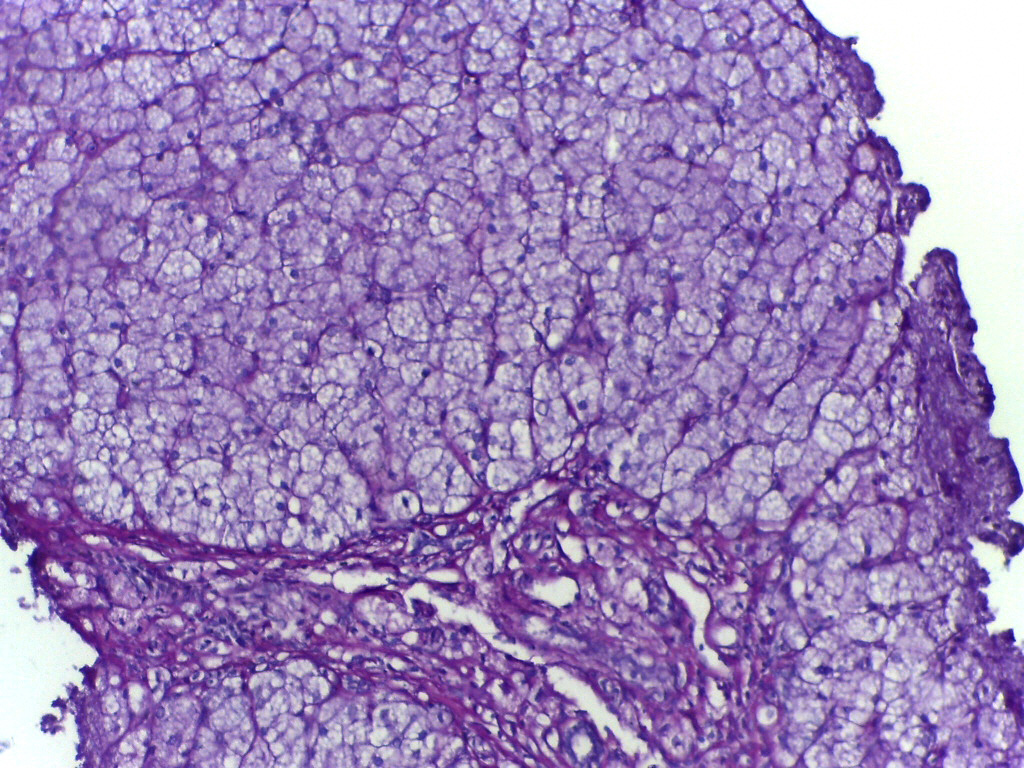Glycogen storage disease type II pathophysiology
|
Glycogen storage disease type II Microchapters |
|
Differentiating Glycogen storage disease type II from other Diseases |
|---|
|
Diagnosis |
|
Treatment |
|
Case Studies |
|
Glycogen storage disease type II pathophysiology On the Web |
|
American Roentgen Ray Society Images of Glycogen storage disease type II pathophysiology |
|
Glycogen storage disease type II pathophysiology in the news |
|
Directions to Hospitals Treating Glycogen storage disease type II |
|
Risk calculators and risk factors for Glycogen storage disease type II pathophysiology |
Editor-In-Chief: C. Michael Gibson, M.S., M.D. [1]; Associate Editor(s)-in-Chief: Anmol Pitliya, M.B.B.S. M.D.[2]
Overview
Glycogen storage disease type 2 (GSD type 2) results due to deficiency of lysosomal enzyme acid α-glucosidase (GAA). GSD type 2 is the most severe type of GSD leading to death in earlier stages of life. Deficiency of GAA leads to accumulation of glycogen in lysosomes of various tissues, most commonly in cardiac, skeletal, and smooth muscle cells. There is a progressive accumulation of glycogen and its substrates in tissues leading to debilitation, organ failure and finally death. GSD type 2 follows an autosomal recessive pattern. GAA gene mutation responsible for lysosomal enzyme acid α-glucosidase (GAA) deficiency in GSD type 2 and is located on chromosome locus 17q25. On gross pathology, characteristic findings of glycogen storage disease type 2 include cardiomegaly and myopathy. On microscopic histopathological analysis, characteristic findings of glycogen storage disease type 2 include muscle has PAS-positive (diastase sensitive) vacuoles.
Pathophysiology
Pathogenesis
- Glycogen storage disease type 2 (GSD type 2) results due to deficiency of lysosomal enzyme acid α-glucosidase (GAA).[1]
- GSD type 2 is the most severe type of GSD leading to death in earlier stages of life.
- Deficiency of GAA leads to accumulation of glycogen in lysosomes of various tissues, most commonly in cardiac, skeletal, and smooth muscle cells.[2]
- There is a progressive accumulation of glycogen and its substrates in tissues leading to debilitation, organ failure and finally death.[3]
- There are a range of severity and varies with:
- Age of onset
- Organ involvement including degree and severity of muscular involvement (skeletal, respiratory, cardiac)
- Rate of progression
- It is believed that movement of muscle and increased myofibril rigidity during contraction leads to rupture of lysosomes in muscle. These ruptured lysosomes in muscles releases glycogen and other lysosomal contents leading to destruction of muscles.[4]
- Other cells including marcophages also deposits glycogen and its substrates in lysosomes. Lysosomes in these tissues usually does not rupture.
Metabolic Pathway

Genetics
- GSD type 2 follows an autosomal recessive pattern.[5]
- GAA gene mutation responsible for lysosomal enzyme acid α-glucosidase (GAA) deficiency in GSD type 2 and is located on chromosome locus 17q25.[6][7][5][8]
Associated Conditions
Conditions associated with glycogen storage disease type 2 include:[9]
Gross Pathology
- On gross pathology, characteristic findings of glycogen storage disease type 2 include cardiomegaly and myopathy.[10]
Microscopic Pathology
- On microscopic histopathological analysis, characteristic findings of glycogen storage disease type 2 include:[9]
 |
 |
- On electron microscopic evaluation of skeletal muscle damage as classic infantile GSD type 2 progress include:[11]
| Stage | Microscopic findings |
|---|---|
| Stage 1 |
|
| Stage 2 |
|
| Stage 3 | |
| Stages 4 |
|
| Stage 5 |
References
- ↑ HERS HG (1963). "alpha-Glucosidase deficiency in generalized glycogenstorage disease (Pompe's disease)". Biochem J. 86: 11–6. PMC 1201703. PMID 13954110.
- ↑ Kishnani PS, Howell RR (2004). "Pompe disease in infants and children". J Pediatr. 144 (5 Suppl): S35–43. doi:10.1016/j.jpeds.2004.01.053. PMID 15126982.
- ↑ ACMG Work Group on Management of Pompe Disease. Kishnani PS, Steiner RD, Bali D, Berger K, Byrne BJ; et al. (2006). "Pompe disease diagnosis and management guideline". Genet Med. 8 (5): 267–88. doi:10.109701.gim.0000218152.87434.f3 Check
|doi=value (help). PMC 3110959. PMID 16702877. - ↑ Griffin JL (1984). "Infantile acid maltase deficiency. I. Muscle fiber destruction after lysosomal rupture". Virchows Arch B Cell Pathol Incl Mol Pathol. 45 (1): 23–36. PMID 6199885.
- ↑ 5.0 5.1 Martiniuk F, Mehler M, Tzall S, Meredith G, Hirschhorn R (1990). "Sequence of the cDNA and 5'-flanking region for human acid alpha-glucosidase, detection of an intron in the 5' untranslated leader sequence, definition of 18-bp polymorphisms, and differences with previous cDNA and amino acid sequences". DNA Cell Biol. 9 (2): 85–94. doi:10.1089/dna.1990.9.85. PMID 2111708.
- ↑ Hoefsloot LH, Hoogeveen-Westerveld M, Kroos MA, van Beeumen J, Reuser AJ, Oostra BA (1988). "Primary structure and processing of lysosomal alpha-glucosidase; homology with the intestinal sucrase-isomaltase complex". EMBO J. 7 (6): 1697–704. PMC 457155. PMID 3049072.
- ↑ Hoefsloot LH, Hoogeveen-Westerveld M, Reuser AJ, Oostra BA (1990). "Characterization of the human lysosomal alpha-glucosidase gene". Biochem J. 272 (2): 493–7. PMC 1149727. PMID 2268276.
- ↑ Kuo WL, Hirschhorn R, Huie ML, Hirschhorn K (1996). "Localization and ordering of acid alpha-glucosidase (GAA) and thymidine kinase (TK1) by fluorescence in situ hybridization". Hum Genet. 97 (3): 404–6. PMID 8786092.
- ↑ 9.0 9.1 Winkel LP, Hagemans ML, van Doorn PA, Loonen MC, Hop WJ, Reuser AJ; et al. (2005). "The natural course of non-classic Pompe's disease; a review of 225 published cases". J Neurol. 252 (8): 875–84. doi:10.1007/s00415-005-0922-9. PMID 16133732.
- ↑ Lim JA, Li L, Raben N (2014). "Pompe disease: from pathophysiology to therapy and back again". Front Aging Neurosci. 6: 177. doi:10.3389/fnagi.2014.00177. PMC 4135233. PMID 25183957.
- ↑ Thurberg BL, Lynch Maloney C, Vaccaro C, Afonso K, Tsai AC, Bossen E; et al. (2006). "Characterization of pre- and post-treatment pathology after enzyme replacement therapy for Pompe disease". Lab Invest. 86 (12): 1208–20. doi:10.1038/labinvest.3700484. PMID 17075580.